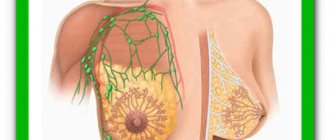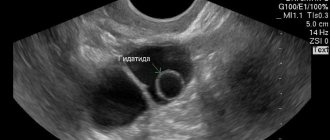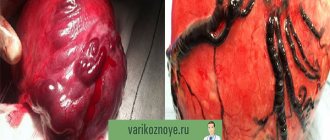When a nursing mother is faced with such a nuisance as lactostasis, an elevated temperature can cause her particular concern. “Isn’t this mastitis?” – the first thing she thinks.
Let's figure out whether there can be an elevated temperature with normal lactostasis, whether it leads to taking antibiotics, and whether it is possible to treat such a disease on your own.
Signs and causes of lactostasis
Lactostasis is the retention of milk in the mammary gland, which causes aching pain and the appearance of lumps. A similar phenomenon can occur in women throughout the lactation period. Swelling and inflammation appear in the affected gland, which further complicates the outflow of milk. The chest becomes painful on palpation. During feeding, the mother may see that the milk is released unevenly: if it “flows like a river” from one lobule, then the flow into the other is much weaker.
The appearance of lactostasis does not depend on the age of the child and the duration of breastfeeding. The formation of congestion is caused by incomplete emptying of the mammary gland or its individual lobes.
The reasons for blockage of the milk ducts during lactostasis may be the following:
- Abnormality of the mother's nipple: it can be flat or inverted.
- A tight bra that tightens the breasts.
- Insufficient pumping.
- Mechanical injuries to the mammary gland, cracked nipples.
- The presence of a “favorite” breast - if a mother feeds the baby predominantly with one of the glands, then milk stagnation will most likely occur in the other.
- Supporting the breast with your fingers during feeding.
- Uncomfortable position during sleep: for example, if a woman prefers to sleep on her stomach.
- Malfunctions of the endocrine system: dehydration, increased sweating.
- Stress, severe fatigue.
- Incorrect attachment of the baby to the breast during feeding, which leads to inadequate and uneven emptying of the breast and blockage of the mammary gland ducts.
Lactostasis and mastitis are closely related to each other, but there are some differences and differences between them. Lactostasis is a milder form of mammary gland disease and occurs without an inflammatory process. But in an advanced stage, blockage of the milk ducts can lead to the development of lactation mastitis with an increase in temperature up to 38 degrees.
Features, symptoms and causes of mastitis
Mastitis is a disease of the mammary gland accompanied by inflammatory processes. Pathology can be of uninfected or infected origin. In the first case, the cause may be breast injury or stagnation of milk in the milk canals. In the second case, the source of the pathogenic process during infection is microorganisms belonging to the species of staphylococci and streptococci. Germs can enter the mammary gland through cracks in the nipples, unwashed hands, or be carried through the blood.
Important! If you have infected mastitis, breastfeeding is prohibited.
Postpartum mastitis is classified into three phases:
- Serous, occurring with symptoms of intoxication.
- Infiltrative – occurs when mastitis is not treated correctly at the serous stage. It is characterized by the appearance of a feverish state and the development of inflammation.
- Purulent - suppuration of a certain segment of the chest.
The most common trigger for the development of mastitis is lactostasis: stagnation of milk in the tubules is a favorite environment for the proliferation of bacteria. The time period is one of the signs of how you can distinguish mastitis from lactostasis. Inflammation in the chest is often the result of untreated blockage of the efferent ducts. Typically, lactostasis transforms into mastitis after 2-3 days.
Signs of breast inflammation are:
- Continuous severe pain in the chest, aggravated by palpation or change in body position. The main thing in this case is not to be lazy and empty the gland completely, despite the pain. Sometimes the situation gets so bad that surgery may be required.
- Redness of the damaged lobule, the presence of painful lumps in the gland. The flow of milk is difficult.
- Dizziness.
- A sharp increase in body temperature to 38.5°, chills.
- The breasts become hot and increase in size.
When an infection occurs, symptoms of intoxication and the appearance of purulent discharge from the nipple are added. The temperature during purulent mastitis can rise to 39-40°.
On a note! If you suspect a disease, you should measure the temperature in the elbow and under both armpits - if the results differ significantly, hyperthermia may be caused by incipient mastitis. However, only a doctor can make an accurate diagnosis.
Comparison of signs of diseases
It can be quite difficult to distinguish lactostasis from mastitis, since the clinical picture for both diseases is similar. However, in the second case, the signs of the disease are more pronounced.
The difference between lactostasis and mastitis can be determined by the following signs:
- Clinical picture. If specific signs of lactostasis are the formation of lumps in the mammary gland, swelling and redness, then with mastitis the breasts become large, hot to the touch and acquire a reddish color.
- Pain. With lactostasis, pain occurs only during palpation. With mastitis, pain persists even at rest.
- Etiology of lactostasis and mastitis. Lactostasis can only appear during breastfeeding. While mastitis can be lactation or non-lactation, which can occur even in men.
- Duration. With proper treatment, lactostasis goes away in 2-3 days. The situation of the patient with mastitis after the same period only worsens and flows into a more acute stage.
- Milk secretion. With lactostasis, milk flows from free channels, the flow of fluid is complicated only in areas of stagnation. After emptying, the chest stops hurting, its condition stabilizes. Expressing during mastitis takes a lot of effort and even after the gland is emptied, the painful sensations persist.
- Jumps in body temperature (up to 38-39°) are observed with mastitis.
- Enlarged lymph nodes are possible only with the development of mastitis.
Table. The main differences between lactostasis and mastitis
In the table below you can see how mastitis differs from lactostasis.
| Signs | Lactostasis | Mastitis |
| General symptoms | The woman's general condition is not deteriorating. Body temperature remains within normal limits | Increased fatigue, drowsiness, headaches. Temperature can rise to 38-38.5° |
| Local manifestations | Swelling and redness of the affected breast. Burning and pain when palpating | The mammary gland becomes red, hot and increases in size. Painful sensations do not go away, even when the chest is at rest |
| Milk release | Difficulties arise when feeding. You can see how milk is released drop by drop from one lobe, and flows from the other in a stream. | It takes a lot of effort to empty your breasts. The pain becomes unbearable |
| Feeling of relief after emptying the breast | Yes | No |
| Enlarged lymph nodes | No | Yes |
| Duration by time | 2-3 days | If after 2-3 days there is an increase in temperature and the development of inflammation, this may indicate serous mastitis |
Day three
In the morning I felt better, despite the fact that I really wanted to sleep. I continued to smear the congestion with traumeel, fed it, applied a cabbage leaf and rested. Already in the afternoon I realized that the lump was gone, that my chest still hurt a little, but with every minute the pain became less and less, and then went away completely. As I expected, everything went away in 2 days.
This was my experience of getting rid of lactostasis. Perhaps it will help someone avoid making mistakes and successfully get rid of lactostasis.
Treatment of diseases
Complete treatment of lactostasis takes from 4 to 6 days, negative symptoms disappear after 3 days. The main treatment method is to frequently place the baby on the affected breast every two hours. It is the baby who will help clear the clogged ducts as soon as possible.
If a woman’s health has not improved, a consultation with a mammologist is necessary. A specialist can prescribe medications, ointments for mastitis and lactostasis of several categories, depending on the patient’s condition:
- Anti-inflammatory creams: Malavit, Traumeel S, Arnica.
- Antipyretic drugs (if the temperature rises above 38°): Ibuprofen and Paracetamol.
- Antispasmodics: No-spa is most often prescribed.
- Compresses using Magnesia. At home, you can apply chopped fresh cabbage leaves.
- Antibiotics are prescribed strictly according to doctor’s indications. Erythromycin is mainly prescribed because with its use you can continue breastfeeding.
It is also useful to use compresses for mastitis and lactostasis. Warm lotions should be applied 10 minutes before feeding - this will relieve vascular spasm and improve blood circulation in the affected area. Cool - after emptying the gland to eliminate swelling and pain.
Important! Some doctors recommend using Vishnevsky ointment, camphor oil and Dimexide for treatment. Such drugs are not suitable for breastfeeding: they easily penetrate into the bloodstream and can harm the baby. There is a high probability that the baby will refuse the breast on his own.
Can antipyretics be used?
As we have already noted, with lactostasis, pumping and latching on the baby helps bring down the temperature. But with mastitis - no. Therefore, it is advisable not to take antipyretics, but to monitor the temperature dynamics after emptying the breast. When the diagnosis has already been made, you can take paracetamol or ibuprofen (the latter, in addition to antipyretic properties, has anti-inflammatory properties).
It is worth keeping in mind that with mastitis, temperature is more productive than with lactostasis, since with its help the body fights infection. But nevertheless, symptomatic treatment is sometimes necessary, as it makes the woman’s condition more tolerable.
Prevention of lactostasis and mastitis
To prevent the development of lactostasis and mastitis, a number of requirements must be observed:
- Make sure your baby is properly attached to the breast.
- Drink more fluids.
- If congestion is detected in one gland, it must be given first.
- Feed the baby “on demand,” offering first one breast and then the other breast alternately (i.e., offer one breast at each feeding so that the baby can empty it completely, and the next the other). When latched correctly, the baby should be positioned towards the site of the blocked duct and his mouth should be opened wide.
- Express if the baby refuses to breastfeed, but no more than 4 times a day.
- Massage the mammary glands with caution when congestion appears (using gentle movements from the edges of the breast to the nipple, paying more attention to those places where compaction occurs).
- Do not stop breastfeeding if lactostasis or mastitis develops. The exception is mastitis of the infected type.
- Pump in the shower. Warm water relaxes the milk ducts, and milk comes out much more easily.
- Change poses, choosing the most comfortable ones. The best option is hand feeding.
- Avoid hypothermia.
Lactostasis is a blockage of the milk ducts in the breast during lactation. If treatment is not started on time, it will transform into mastitis, the main symptom of which is the inflammatory process. If lumps in the mammary gland do not disappear after 2-3 days, you should consult a doctor to establish the correct diagnosis and prescribe appropriate medications.
The first day
Lactostasis began unexpectedly. I must say that I didn’t even understand how it happened. Maybe I awkwardly lifted the stroller, got nervous, tired, maybe I pinched my chest. I still think that all these factors came together. We walked outside with the whole family, and when we came home, I felt that I had some kind of lump in my chest. Within an hour, chills began, and then weakness and even nausea set in. I fell ill. They measured the temperature - it was 38. It finally dawned on me that it was lactostasis. After 1.5 years of successful breastfeeding, I still had to experience for myself what it was like. I couldn't even imagine that it was so hard.
♥Peace and sleep
I realized that to a greater extent I provoked lactostasis myself, namely my unstable emotional state. I was thrown out of balance, experiencing internal changes, and here you go - lactostasis, in the second year of breastfeeding. I don't think this is just a coincidence.
I knew for sure that in order to feel better I needed to lie down and rest. Lactostasis is a clear indicator that there were unexpressed emotions inside, that I was tired and I definitely needed rest. I felt this deeply.
I needed to sleep for a couple of hours and no one should bother me. I fed my son and asked my husband to go for a walk outside. And I myself lay down and fell asleep. Peace and quiet is what you need for lactostasis. If you have the opportunity to lie in silence, do it.
♥Frequent applications
I tried to hold the baby as often as possible so that he would dissolve the lump. We had to feed him in different positions, trying to place his chin towards the place of stagnation - this way lactostasis goes away faster.
Lie down and feed... Don’t run to prepare dinner or work with the child, but just lie down and feed. Playing a game called “I’m a log” with lactostasis is recommended for everyone. This is when you lie down like a log on the bed, and you don’t get out of it all day, don’t move anywhere and rest. And sometimes it’s useful to play this game just like that, without waiting for some kind of illness to strike. After all, our bodies, especially active girls, will sooner or later put us to rest. But it is better to do it voluntarily.
♥Adequate amount of liquid.
I drank pure water, because I knew that with lactostasis you need to drink according to thirst, and not limit your drinking. Normally, this is about eight glasses of water a day. The situation will not improve just because you don't drink water. Water is very important.
♥Paracetamol
On the first day I felt very bad. The temperature was under 38, my chest hurt and there was terrible weakness. I took a paracetamol tablet to ease my condition. I don’t like taking medications, but here I felt unbearably bad.
♥Cold compresses
At night I saved myself by applying cold compresses to my chest. No alcohol compresses, I knew this by heart, but only cold compresses or cabbage leaves. These compresses really relieved pain and swelling, it became easier. But I understood that tomorrow morning my husband would go for cabbage.
♥Light massage
You couldn’t knead your breasts, and even more so you couldn’t hurt yourself with such a massage. I know that there are specialists who “strain” through wild pain. As a result, they only make it worse and also charge money for it... Light massage from the periphery to the nipple, only light touches, no pain.











